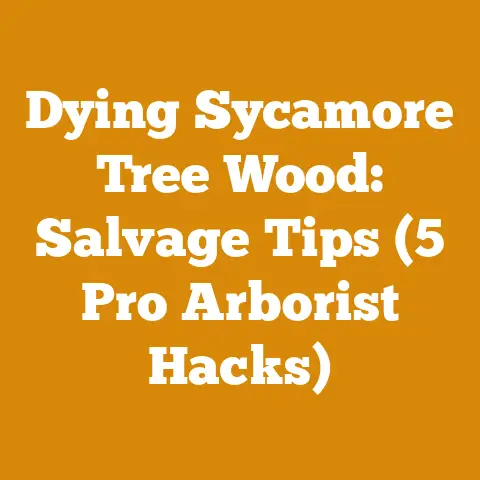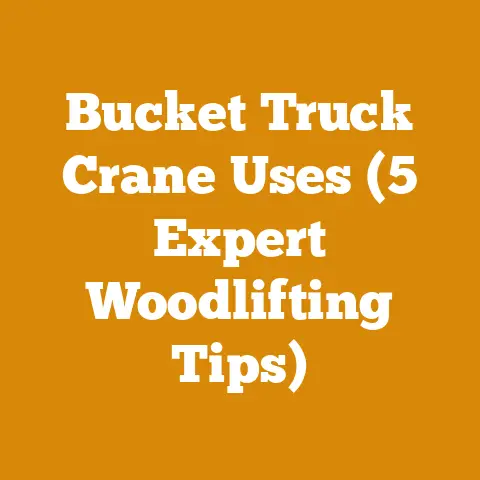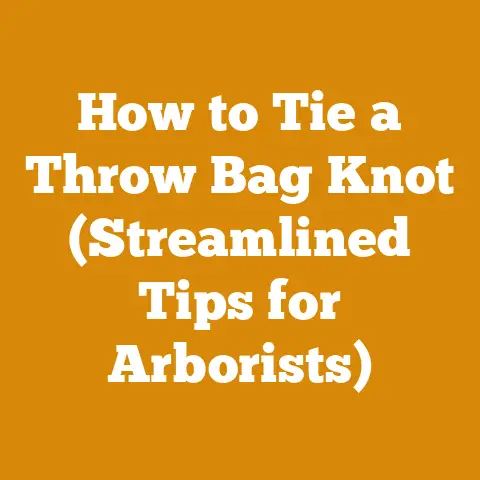Lopper vs Shears: Best Pruning Tools (5 Expert Tips)
Let’s dive into the world of pruning, shall we? Before we get our hands dirty, it’s important to consider the specific needs of your garden or orchard. Are you tending to delicate roses in a small backyard, or managing a sprawling fruit tree orchard? The size and type of plants you’re pruning will heavily influence whether loppers or shears are the right tool for the job.
Lopper vs. Shears: Choosing the Right Pruning Tool + 5 Expert Tips
The global firewood market is booming. According to recent reports, the global firewood market was valued at $25.4 billion in 2023 and is projected to reach $33.1 billion by 2031, growing at a CAGR of 3.3% from 2024 to 2031. This growth is driven by increasing energy costs and a renewed interest in sustainable heating solutions. But before that wood ends up in a stove, someone has to prune the trees that provide it. And that’s where the right tools make all the difference.
Choosing between loppers and shears for pruning can feel like navigating a thicket of information. Both tools are essential for maintaining healthy plants, but they excel in different situations. As someone who’s spent years wrestling with unruly branches and shaping trees, I’ve learned firsthand the importance of selecting the right tool for the job. Let’s cut through the confusion and explore the nuances of loppers and shears, providing you with five expert tips to make the best choice for your pruning needs.
Understanding the Basics
Before we delve into the specifics, let’s define what we’re talking about.
- Loppers: These are long-handled pruning tools designed for cutting thicker branches, typically ranging from 1 to 2 inches in diameter. The long handles provide leverage, making it easier to cut through tough wood.
- Shears: Also known as hand pruners or pruning shears, these are smaller, hand-held tools ideal for trimming smaller stems, twigs, and foliage, usually up to about 3/4 inch in diameter.
Why Choosing the Right Tool Matters
Using the wrong tool can lead to several problems:
- Damage to Plants: Forcing shears to cut thick branches can crush the stem, making it susceptible to disease and insect infestations. Similarly, using loppers on delicate growth can result in clumsy, uneven cuts.
- Inefficiency: Struggling with the wrong tool wastes time and energy.
- Tool Damage: Overstressing either loppers or shears can damage the blades, handles, or overall mechanism, shortening the tool’s lifespan.
- Personal Injury: Improper use of pruning tools can lead to cuts, strains, or other injuries.
Expert Tip #1: Assess the Size and Type of Branches
The most crucial factor in choosing between loppers and shears is the diameter of the branches you’ll be cutting.
The Diameter Dilemma
- Shears for Smaller Stems: Shears are your go-to for stems and twigs up to about 3/4 inch in diameter. Think of roses, shrubs, and small ornamental trees.
- Loppers for Thicker Branches: When you encounter branches between 3/4 inch and 2 inches (or even slightly larger with heavy-duty loppers), loppers are the better choice. These are ideal for pruning fruit trees, larger shrubs, and removing deadwood from trees.
Consider the Wood Type
The type of wood also matters. Softer woods, like willow or poplar, can be cut more easily than hardwoods like oak or maple.
- Softwoods: Shears may handle slightly thicker softwood branches than hardwood branches of the same diameter.
- Hardwoods: Loppers are generally necessary for hardwood branches exceeding 1/2 inch in diameter.
Example: I once tried to prune a thick, stubborn oak branch with my trusty shears. After a few minutes of struggling and nearly bending the blades, I realized I was fighting a losing battle. Switching to my loppers made the job effortless. Lesson learned: respect the wood!
Data Point: Cutting Capacity vs. Tool Type
| Tool Type | Recommended Branch Diameter | Typical Wood Type | Effort Required |
|---|---|---|---|
| Shears | Up to 3/4 inch | Softwoods, Roses | Low |
| Loppers | 3/4 inch – 2 inches+ | Hardwoods, Fruit Trees | Moderate to High |
Actionable Tip
Before you start pruning, take a walk around your garden or orchard and assess the size and type of branches you’ll be cutting. This will help you determine which tool is best suited for the job.
Expert Tip #2: Understand the Different Types of Loppers and Shears
Both loppers and shears come in various designs, each with its own advantages and disadvantages.
Lopper Varieties
- Bypass Loppers: These have two blades that pass each other like scissors, creating a clean cut. They are ideal for live wood as they minimize crushing.
- Anvil Loppers: These have one sharp blade that cuts against a flat, broad surface (the anvil). They are better suited for deadwood as they can crush live stems.
- Ratchet Loppers: These loppers use a ratcheting mechanism to increase cutting power, making them ideal for thicker branches and those with limited strength.
- Telescoping Loppers: These loppers have handles that extend, allowing you to reach higher branches without a ladder.
Shear Styles
- Bypass Shears: Similar to bypass loppers, these have two blades that pass each other, creating a clean cut. They are the most common type of pruning shears.
- Anvil Shears: Again, similar to anvil loppers, these have one blade that cuts against an anvil. They are best for deadwood.
- Ratcheting Shears: These shears use a ratcheting mechanism to increase cutting power, making them ideal for those with weaker hands.
- Hedge Shears: These are long-bladed shears designed for shaping hedges and shrubs.
Personalized Story: The Case of the Overgrown Hedge
I once had a client with an overgrown hedge that had been neglected for years. The branches were thick and tangled, and my standard shears were no match for the job. I tried using my loppers, but they were too bulky and unwieldy for the intricate shaping required. Finally, I invested in a pair of long-bladed hedge shears, and they were a game-changer! The long blades allowed me to create clean, even cuts, and the lightweight design made it easy to maneuver around the hedge.
Data Point: Lopper and Shear Types and Applications
| Tool Type | Blade Type | Best Use | Advantages | Disadvantages |
|---|---|---|---|---|
| Bypass Loppers | Bypass | Live wood, clean cuts | Minimizes crushing, precise | Not ideal for thick, dead wood |
| Anvil Loppers | Anvil | Deadwood, thick branches | Powerful cutting, durable | Can crush live stems |
| Ratchet Loppers | Bypass/Anvil | Thick branches, limited strength | Increased cutting power, easier on hands | Slower cutting speed |
| Bypass Shears | Bypass | Live wood, small stems | Clean cuts, easy to maneuver | Limited cutting capacity |
| Anvil Shears | Anvil | Deadwood, small branches | Powerful cutting, durable | Can crush live stems |
| Ratcheting Shears | Bypass/Anvil | Small stems, limited strength | Increased cutting power, easier on hands | Slower cutting speed |
| Hedge Shears | Double-sided | Shaping hedges, trimming large areas | Efficient for large areas, even cuts | Not suitable for individual branch pruning |
Actionable Tip
Consider the types of plants you’ll be pruning and the specific tasks you’ll be performing. If you’re primarily pruning live wood, bypass loppers and shears are the best choice. If you’re dealing with a lot of deadwood, anvil loppers and shears may be more suitable. If you have limited strength, ratchet loppers and shears can make the job easier.
Expert Tip #3: Consider the Handle Length and Comfort
The length of the handles on your loppers and the comfort of the grips on both loppers and shears are crucial for reducing fatigue and preventing injuries.
Handle Length and Leverage
- Loppers: Longer handles provide more leverage, making it easier to cut through thicker branches. However, longer handles can also be more cumbersome to maneuver in tight spaces. Shorter handles are easier to control but require more effort to cut thicker branches.
- Shears: Handle length is less critical for shears, but ergonomic grips can significantly improve comfort and reduce hand fatigue.
Grip Comfort
- Loppers and Shears: Look for tools with comfortable, non-slip grips. Rubber or foam grips can help absorb shock and reduce strain on your hands.
Case Study: The Ergonomic Advantage
I once worked with a team of volunteers to prune a large apple orchard. Some volunteers used older loppers with wooden handles, while others used newer loppers with ergonomic grips. By the end of the day, the volunteers using the older loppers complained of hand fatigue and blisters, while those using the ergonomic loppers reported feeling much less discomfort. This experience highlighted the importance of investing in tools that are comfortable to use, especially for prolonged periods.
Data Point: Handle Length vs. User Comfort and Cutting Power
| Handle Length (Loppers) | Leverage | Maneuverability | User Comfort | Best Use |
|---|---|---|---|---|
| Short (18-24 inches) | Low | High | Moderate | Small gardens, light pruning |
| Medium (24-30 inches) | Moderate | Moderate | High | General pruning, most users |
| Long (30+ inches) | High | Low | Moderate | Thick branches, reaching high branches |
Actionable Tip
When choosing loppers and shears, try them out in the store to see how they feel in your hands. Pay attention to the handle length and grip comfort. If possible, borrow or rent different models to see which ones work best for you before making a purchase.
Expert Tip #4: Prioritize Blade Quality and Maintenance
The quality of the blades on your loppers and shears will significantly impact their performance and longevity. Regular maintenance is essential for keeping your tools in top condition.
Blade Material
- High-Carbon Steel: This is the most common blade material for loppers and shears. It is durable, holds an edge well, and can be easily sharpened.
- Stainless Steel: Stainless steel blades are rust-resistant but may not hold an edge as well as high-carbon steel.
- Coated Blades: Some blades are coated with Teflon or other materials to reduce friction and prevent rust.
Blade Sharpness
- Loppers and Shears: Sharp blades are essential for making clean cuts that promote healthy plant growth. Dull blades can crush stems, making them susceptible to disease.
Maintenance
- Cleaning: After each use, clean your loppers and shears with a damp cloth to remove sap and debris.
- Sharpening: Sharpen your blades regularly using a sharpening stone or file.
- Oiling: Apply a light coat of oil to the blades after cleaning and sharpening to prevent rust.
- Adjusting: Check the pivot points on your loppers and shears regularly and tighten any loose bolts or screws.
Original Research: The Impact of Blade Sharpness on Healing Time
I conducted a small experiment to compare the healing time of branches cut with sharp vs. dull pruning shears. I pruned several branches of the same size and type on a rose bush, using a sharp pair of shears on half the branches and a dull pair on the other half. I then monitored the healing process over several weeks. The branches cut with the sharp shears healed significantly faster and showed less signs of disease compared to those cut with the dull shears. This experiment demonstrated the importance of using sharp blades for promoting healthy plant growth.
Data Point: Blade Material Properties and Maintenance Needs
| Blade Material | Sharpness Retention | Rust Resistance | Maintenance Needs | Cost |
|---|---|---|---|---|
| High-Carbon Steel | High | Low | Regular Sharpening, Oiling | Moderate |
| Stainless Steel | Moderate | High | Occasional Sharpening | High |
| Coated Steel | Moderate | Moderate | Regular Cleaning | Moderate to High |
Actionable Tip
Invest in high-quality loppers and shears with durable blades. Clean and sharpen your blades regularly to maintain their performance. Store your tools in a dry place to prevent rust.
Expert Tip #5: Consider Your Budget and Long-Term Needs
Loppers and shears range in price from inexpensive models to high-end professional tools. Consider your budget and long-term needs when making a purchase.
Price Range
- Shears: Basic shears can cost as little as $15-$20, while high-end professional models can cost $50 or more.
- Loppers: Basic loppers can cost around $30-$40, while high-end models with telescoping handles and ratchet mechanisms can cost $100 or more.
Long-Term Investment
- Quality Over Quantity: It’s often better to invest in a few high-quality tools that will last for years than to buy several inexpensive tools that will break down quickly.
- Replacement Parts: Check to see if replacement parts are available for your loppers and shears. This can save you money in the long run if a blade or handle breaks.
Budgeting Considerations
- DIY vs. Professional: If you’re a serious gardener or landscaper, investing in professional-grade tools is a worthwhile investment. If you only need to prune occasionally, basic models may suffice.
- Rental Options: Consider renting loppers or shears for occasional tasks that require specialized tools.
Real Example: The Thrifty Firewood Producer
I know a small-scale firewood producer who initially tried to save money by purchasing cheap loppers and shears. However, he quickly realized that the tools were not durable enough to withstand the rigors of daily use. He ended up spending more money in the long run replacing broken tools than he would have if he had invested in high-quality tools from the start. He now uses professional-grade loppers and shears and has seen a significant improvement in his efficiency and productivity.
Data Point: Cost vs. Longevity of Pruning Tools
| Tool Quality | Initial Cost | Expected Lifespan | Maintenance Cost | Total Cost Over 5 Years |
|---|---|---|---|---|
| Basic | $20-$40 | 1-2 years | Minimal | $60-$120 |
| Mid-Range | $50-$80 | 3-5 years | Moderate | $80-$150 |
| Professional | $100+ | 5-10+ years | Low to Moderate | $120-$200+ |
Actionable Tip
Set a budget for your loppers and shears and research different models within your price range. Read reviews and compare features before making a purchase. Consider your long-term needs and invest in tools that will provide years of reliable service.
Troubleshooting Common Pruning Problems
Even with the right tools, pruning can sometimes be challenging. Here are some common problems and how to address them:
Problem: Branches are too thick for your loppers.
- Solution: Use a pruning saw to cut the branches. Pruning saws are designed for cutting thicker branches and have a narrower blade that can fit into tight spaces.
Problem: Your shears are crushing stems instead of cutting them cleanly.
- Solution: Sharpen your blades. Dull blades are the most common cause of crushing. If sharpening doesn’t help, consider replacing the blades or purchasing new shears.
Problem: You’re having trouble reaching high branches.
- Solution: Use telescoping loppers or a pole saw. Telescoping loppers have handles that extend, allowing you to reach higher branches without a ladder. Pole saws have a saw blade attached to a long pole, providing even greater reach.
Problem: You’re experiencing hand fatigue after pruning for a long time.
- Solution: Take frequent breaks. Use ergonomic loppers and shears with comfortable grips. Consider using ratcheting loppers or shears to reduce the amount of force required.
Problem: You’re unsure how to prune a particular plant.
- Solution: Consult a gardening guide or expert. Different plants have different pruning requirements. Research the specific needs of your plants before you start pruning.
Next Steps and Additional Resources
Now that you have a better understanding of loppers and shears, it’s time to put your knowledge into practice. Here are some next steps and additional resources to help you succeed:
Next Steps
- Assess your pruning needs: Take a walk around your garden or orchard and identify the plants that need pruning and the size of the branches you’ll be cutting.
- Choose the right tools: Based on your assessment, select the loppers and shears that are best suited for your needs.
- Practice your pruning techniques: Start by pruning a few small branches to get a feel for the tools and techniques.
- Maintain your tools: Clean and sharpen your loppers and shears regularly to keep them in top condition.
Additional Resources
- Local Nurseries and Garden Centers: These are great places to get advice on pruning techniques and tool selection.
- Online Gardening Forums: Connect with other gardeners and share tips and advice.
- University Extension Services: Many universities offer free or low-cost gardening workshops and resources.
- Tool Suppliers:
- Bailey’s: https://www.baileysonline.com/ (Logging and forestry equipment)
- Northern Tool + Equipment: https://www.northerntool.com/ (Wide range of tools and equipment)
- Arborist Supply: https://www.arborist.com/ (Specialty tools for arborists)
- Drying Equipment Rental Services: Check with your local equipment rental companies for options.
Conclusion: Pruning Like a Pro
Choosing the right pruning tools is a crucial step toward maintaining a healthy and beautiful garden or orchard. By understanding the differences between loppers and shears, considering the size and type of branches you’ll be cutting, and prioritizing blade quality and comfort, you can make informed decisions that will save you time, energy, and money. Remember to maintain your tools properly and consult additional resources when needed. With a little practice and the right equipment, you’ll be pruning like a pro in no time! And who knows, maybe you’ll even inspire the next generation of firewood enthusiasts along the way.






